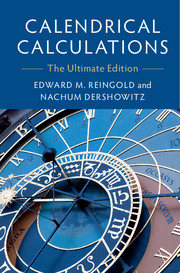Book contents
- Frontmatter
- Dedication
- Contents
- List of Frontispieces
- List of Figures
- List of Tables
- List of Calendar Functions
- Abbreviations
- Mathematical Notations
- Preface
- Credits
- License and Limited Warranty and Remedy
- 1 Calendar Basics
- I Arithmetical Calendars
- II Astronomical Calendars
- 14 Time and Astronomy
- 15 The Persian Calendar
- 16 The Bahá’í Calendar
- 17 The French Revolutionary Calendar
- 18 Astronomical Lunar Calendars
- 19 The Chinese Calendar
- 20 The Modern Hindu Calendars
- 21 The Tibetan Calendar
- Coda
- III Appendices
- References
21 - The Tibetan Calendar
from II - Astronomical Calendars
Published online by Cambridge University Press: 22 March 2018
- Frontmatter
- Dedication
- Contents
- List of Frontispieces
- List of Figures
- List of Tables
- List of Calendar Functions
- Abbreviations
- Mathematical Notations
- Preface
- Credits
- License and Limited Warranty and Remedy
- 1 Calendar Basics
- I Arithmetical Calendars
- II Astronomical Calendars
- 14 Time and Astronomy
- 15 The Persian Calendar
- 16 The Bahá’í Calendar
- 17 The French Revolutionary Calendar
- 18 Astronomical Lunar Calendars
- 19 The Chinese Calendar
- 20 The Modern Hindu Calendars
- 21 The Tibetan Calendar
- Coda
- III Appendices
- References
Summary
The Tibetan system of astronomy and astrology is extremely complex. It takes five years to study and master it at the Astro Division of the TibetanMedical and Astro Institute in Dharamsala, India. Students learn to calculate everything by hand in the traditional manner, on a wooden board covered with soot upon which one writes with a stylus. There is no complete ephemeris compiled in which to look up figures. One of the main aspects of the training is the mathematics involved in all the calculations.
Alexander Berzin (1986)Calendar
Brown's tables fill 650 quarto pages, and even with the tables a man working full time could extract the data just fast enough to keep up with the moon. The advent of the electronic calculator made feasible the direct evaluation of the formulas and … improved accuracy.
Wallace J. Eckert: Encyclopædia Britannica (1964)Several calendars are in use in Tibet. In this chapter we discuss the official Phuglugs (or Phug-pa or Phukluk) version of the Kālacakra (“Wheel of Time”) calendar, derived from the Kālacakra Tantra, translated into Tibetan from the Sanskrit in the eleventh century, used by the majority of Tibetans today, and sanctioned by the Dalai Lama. (The other widely used version is the Tsurphu.) The calendar is similar to the Hindu lunisolar calendars, somewhere between the arithmetic simplicity of the old Hindu version, and the astronomical complexity of the modern Hindu. There are also regional variants, because the calculated astronomical events are in terms of local time. The Bhutan, Mongolian, and Sherpa calendars are very similar.
Months are lunar; their length is based on an approximation to the varying length of the true synodic month, and can be 29 or 30 civil days long. Months are numbered consecutively, except for leap months, which precede their ordinary counterparts, as on the Hindu lunisolar calendar, and are named and numbered the same. The month names in Tibetan are:
Weekdays are named in Tibetan as follows:
There are several conventions for naming years. The most common is to use a 60-year cycle, naming them either like the Hindu Jovian years (Section 10.1), or using simultaneous 12-totem and 5-element cycles, in the fashion of the Chinese calendar (Section 19.4).
- Type
- Chapter
- Information
- Calendrical CalculationsThe Ultimate Edition, pp. 375 - 384Publisher: Cambridge University PressPrint publication year: 2018



